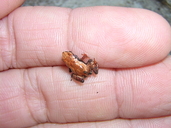|
Description
Eleutherodactylus cubanus is a tiny frog, measuring only 14 mm in adult females, with the males being smaller. The dorsum is slightly warty, and the venter is smooth. The digits and digital discs are very small. There is no webbing between the toes. Vomerine teeth are absent
(Barbour and Shreve 1937; Schwartz and Henderson 1985; Schwartz and Henderson 1991; Hedges et al. 1995).
This frog is reddish-brown to tan-brown dorsally, with lighter tan or brown dorsolateral areas. The head is mahogany or dark brown. A narrow light tan mid-dorsal stripe extends from snout to vent, and onto the posterior face of each thigh. A dark brown lateral region extends from the tip of the snout to the groin region and onto the anterior surfaces of the thighs. One or two dark brown or black sacral spots are present. The front limbs are bright red or orange above and below, with brown digital tips. The hind limbs are similar to the dorsum with inconspicuous and irregular darker bands, while the feet are dark orange. The venter and underside of the hind limbs are dark brown with some white flecks or dots. The chin and throat are reddish-tan or orange mottled with white, with this color extending to the level of the front limbs. Eyes are dark brown with a tinge of copper above
(Barbour and Shreve 1937; Schwartz and Henderson 1985; Schwartz and Henderson 1991; Hedges et al. 1995). Distribution and Habitat
Country distribution from AmphibiaWeb's database: Cuba
This species is endemic to Cuba and it is known only from Sierra del Turquino in the Sierra Maestra mountains, eastern Cuba, at elevations between 1060-1400 m. It has been collected from just two localities in 60 years, one on the south slope near Cueva del Aura (Barbour and Shreve 1937, as E. parvus), and one on the north slope, on the trail to Pico Turquino at the El Joaquín field station (Hedges et al. 1995). This is a terrestrial species found in the leaf litter of rainforests, cloud forests and pine woods
(Schwartz and Henderson 1991; Hedges et al. 1995; Diaz et al. 2005).
Life History, Abundance, Activity, and Special Behaviors
The vocalization is similar to that of E. limbatus. This frog is a direct developing species, which lays a single egg at a time (i.e., the clutch size is one)
(Hedges et al. 1995; Fong unpublished).
Other aspects of the natural history of this frog are unknown.
This species does not appear to be abundant. Trends and Threats
Habitat loss due to anthropogenic activity (logging, road construction and coffee cultivation) seem be the greatest threats to this species
(Diaz 1998).
Other threats include habitat destruction due to disturbance from tourist activities, as well as infrastructure development for human settlement
(Hedges and Diaz 2004). In addition, chytridiomycosis has recently been reported from Cuba, and it is not yet known how extensively the disease has spread within the country (Díaz et al. 2007). Direct-developing species like Eleutherodactylus cubanus are considerably less likely to be affected by chytridiomycosis than are species with free-living tadpoles, but chytrid infection has been reported in a related direct-developing species from Puerto Rico, Eleutherodactylus coqui (Beard and O'Neill 2005). Possible reasons for amphibian decline General habitat alteration and loss
Habitat modification from deforestation, or logging related activities
Intensified agriculture or grazing
Urbanization
Local pesticides, fertilizers, and pollutants
Comments
Eleutherodactylus cubanus is a member of the subgenus Euhyas.
(Heinicke et al. 2007).
References
Barbour, T., and Shreve, B. (1937). “Novitates Cubanae.” Bulletin of the Museum of Comparative Zoology, 80(9), 377-387.
Beard, K. H., and O'Neill, E. M. (2005). ''Infection of an invasive frog Eleutherodactylus coqui by the chytrid fungus Batrachochytrium dendrobatidis in Hawaii.'' Biological Conservation, 126, 591-595.
Drewes, R. C., and Wilkinson, J. A. (2004). ''The California Academy of Sciences Gulf of Guinea Expedition (2001) I. The taxonomic status of the genus Nesionixalus Perret, 1976 (Anura: Hyperoliidae): treefrogs of São Tomé and Príncipe, with comments on the genus Hyperolius.'' Proceedings of the California Academy of Sciences, 55, 395-407.
Díaz, L. M. (1998). ''Taxon Data Sheet for Eleutherodactylus cubanus.'' Report on Conservation Assessment Plan Workshop for Selected Cuban Species. Pérez, E., Osa, E., Matamoros, Y., and Seal, U. S., eds., IUCN/SSC Conservation Breeding Specialist Group, Apple Valley, Minnesota., 117-123.
Díaz, L. M., Cádiz, A., Chong, A., and Silva, A. (2007). ''First report of chytridiomycosis in a dying toad (Anura: Bufonidae) from Cuba: A new conservation challenge for the island.'' Ecohealth, 4(2), 172-175.
Díaz, L. M., Fong, A., Viña, N., and Knell, G. (2005). ''Amphibians and reptiles.'' Cuba: Parque Nacional La Bayamesa. Rapid Biological Inventories Report 13. D. Maceira, A. Fong, W. S. Alverson, and T. Wachter, eds., The Field Museum, Chicago.
Hedges, S. B. and Díaz, L. M. 2004. Eleutherodactylus cubanus. In: IUCN 2007. 2007 IUCN Red List of Threatened Species. http://www.iucnredlist.org/. Downloaded on 11 November 2007.
Hedges, S. B., González, L., and Estrada, A. R. (1995). ''Rediscovery of the Cuban frogs Eleutherodactylus cubanus and E. turquinensis (Anura: Leptodactylidae).'' Caribbean Journal of Science, 31(3-4), 327-332.
Heinicke, M. P., Duellman, W. E., Hedges, S. B. (2007). ''Major Caribbean and Central American frog faunas originated by ancient oceanic dispersal.'' Proceedings of the National Academy of Sciences of the United States of America, 104(24), 10092-10097.
Schwartz, A., and Henderson, R. W. (1985). A Guide to the Identification of the Amphibians and Reptiles of the West Indies Exclusive of Hispaniola. Milwaukee Public Museum, Inland Press, Milwaukee.
Schwartz, A., and Henderson, R. W. (1991). Amphibians and Reptiles of the West Indies. Descriptions, Distributions, and Natural History. University of Florida Press, Gainesville, Florida, USA.
Originally submitted by: Ansel Fong G. (first posted 2007-11-07)
Edited by: Kellie Whittaker (2008-10-26)Species Account Citation: AmphibiaWeb 2008 Eleutherodactylus cubanus: Turquino Red-armed Frog <https://amphibiaweb.org/species/2875> University of California, Berkeley, CA, USA. Accessed Apr 18, 2024.
Feedback or comments about this page.
Citation: AmphibiaWeb. 2024. <https://amphibiaweb.org> University of California, Berkeley, CA, USA. Accessed 18 Apr 2024.
AmphibiaWeb's policy on data use.
|
